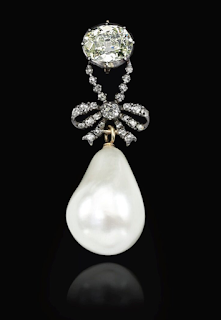Hosted by Sothesby's, the jewels belonging to the Bourbon-Parma family were sold in 2018. These included jewels that once adorned the Queen of Fashion herself - Marie Antoinette. But how did the ill-fated queen's jewels end up there?
Most of the royal family's Crown Jewels were sold by the revolutionaries and often broken up into pieces. However, the beleaguered royal family did manage to smuggle out some pieces which were sent to the queen's nephew, the Emperor of Austria-Hungary. From there, they passed through the hands of several royal families before finally ending up on the auction block at Sothesby's. As such, it should be remembered, that the diamonds, pearls and other precious stones are not necessarily in the original design - almost the contrary. It was not uncommon to have diamonds reset in modern patterns; besides the smuggling itself would occasionally require pieces to be broken up.
Nevertheless, these were the magnificent jewels whose origin can be traced back directly to Marie Antoinette or others connected with the court of Versailles (NOTE: unless stated otherwise, the photos were taken by Sothesby's to whom credit goes).
A superb diamond parure
In order to create this stunning diamond parure, a great deal of exquisite stones were needed; many of which came from the collections of persons connected with Versailles. The five largest stones are believed to have been the property of Marie Antoinette while others belonged to her daughter, Madame Royale, and the Duc de Berry.
Price realised: 855.000 CHF (724.128 pounds)
A pearl necklace with clasp
While the (detachable) rows of pearls are impressive in themselves, it is the clasp that warrants closer attention. Once, Marie Antoinette had a matching pair of bracelets with that very clasp and also six rows of pearls. It is a pretty good example of how a piece can be altered into a new purpose.
Price realised: 100.000 CHF (84.693 pounds)
Three diamond rings
These rings must have meant something special to Madame Royale, as they were left to her by her mother, Marie Antoinette. The first ring is mounted with diamonds and contains a profile miniature of the late queen herself.
Price realised: 250.000 CHF (211.733 pounds)
The second ring shows Marie Antoinette's monogram set in diamonds. The ring also contains another, more personal remnant of the queen: a lock of her hair. Undoubtedly, that is why the ring was sold for such an exuberant amount.
Price realised: 447.000 CHF (378.579 pounds)
The last shows the letters MD for Monseiur le Dauphin, Madame Royale's grand-father (he is better known as Louis-Ferdinand). Naturally, Louis-Ferdinand and Madame Royale would never meet but it must have been a reminder of the family that she had lost. It had once been in the possession of Marie-Josèphe de Saxe, mother of Louis XVI.
Price realised: 125.000 CHF (105.866 pounds)
The queen's pearls
This is one of the pieces that is closest to its original form. When Marie Antoinette owned the necklace, it was longer and included the pearls from both images. They were later split up to form the two separate necklaces we see today. The necklace contains no less 119 pearls (of which just three are freshwater pearls).
The clasp of the first, three-rowed necklace is in the shape of a star and is set in diamonds. The clasp was added later, so it is not a part of the original piece.
Price realised for the first: 2.295.000 CHF (1.943.713 pounds)
Price realised for the second: 447.000 CHF (378.579 pounds)
These earrings are also made up of pearls that belonged to the same necklace as the ones above. It has later been set with diamonds. All four pearls were saltwater and the "new" design is from the early 19th century.
Price realised: 447.000 CHF (378.579 pounds)
However, that is not the end of the pearl necklace! The original piece was adorned with a pearl pendant which is now an individual brooch but otherwise in the same fashion as before. The large pearl dangles from a bow of smaller diamonds which again are suspended from a large, oval diamond.
This piece was one of the most expensive at the auction and fetched a record price of 36.427.000 CHF! For those of us who do not usually deal with Swiss francs this is 30.851.260 pounds.
In case you are having a hard time imagining the original piece in all its glory, Sotheby's attached the following image:
A diamond brooch
The trend of bow-shaped brooches was popular throughout most of the latter half of the 18th century. This particular diamond bow belonged to Marie Antoinette. The large, yellow diamond is detachable. Originally, the brooch was a part of a set including possibly a tiara.
Price realised: 2.115.000 (1.791.265 pounds)
A golden pocket-watch
This golden pocket watch looks rather modern compared to the other pieces. When opened, it displays the queen's initials, MA, and three fleurs-de-lys. Besides the gold, the watch is adorned with many small pearls and blue enamel. It would have hung from a chain.
Price realised: 250.000 CHF (211.733 pounds).
The entire auction included 100 lots - some of the pieces have not been seen in public for more than 200 years, as they have been privately owned. The ten pieces that originally belonged to Marie Antoinette sold for a total of 33.740.293 pounds!













